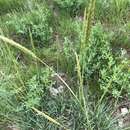pt-BR
nomes no trilho de navegação


The following description of Colorado wildrye provides characteristics that may be relevant to fire ecology, and is not meant for identification. Keys for identification are available (e.g. [10,13,41,42]).
Colorado wildrye is a native, loosely caespitose perennial [10,13,21,23] that forms culms 12 to 43 inches (30-110 cm) tall [10,13].
Colorado wildrye leaves are mostly basal [10,13,21] and may be flat [10,41,42] or involute [13,15]. Leaves are 0.04 to 0.24 inch (1-6 mm) wide [13,15] and glabrous to sparsely pubescent [10]. Compared with the morphologically similar Salina wildrye (L. salinus), Colorado wildrye tends to be more lush in appearance due to its abundant vegetative growth and leafy culms [10].
Colorado wildrye spikes are erect and reach 3 to 7 inches (8-17 cm) long and 0.08 to 0.24 inch (2-6 mm) wide [10,13]. Spikelets may be paired or solitary at each node [10,13,41,42] and are 0.4 to 0.9 inch (10-23 mm) long [13]. Spikelets bear 2 to 10 flowers [10,13].
Colorado wildrye occasionally produces short rhizomes [10,21].
Colorado wildrye grows primarily along the east slope of the Rocky Mountains, from Montana south through Wyoming, Colorado, and New Mexico [7,10,23]. It has also been reported in Idaho [35], Utah [23], and Nevada [24].
Plants database provides a distributional map of Colorado wildrye.
Fire adaptations: Review of the available literature yielded no information pertaining specifically to the fire ecology or adaptations of Colorado wildrye. Further study is needed to clarify the relationship between fire and Colorado wildrye. Basin wildrye (L. cinereus) is a morphologically similar species, though it occurs on somewhat different sites and has a wider distribution. Information on fire ecology and adaptations of basin wildrye can be found in the FEIS species summary; it is unknown to what extent this information can be applied to Colorado wildrye.
FIRE REGIMES: Fire return intervals for plant communities and ecosystems in which Colorado wildrye occurs are summarized below. Find further fire regime information for the plant communities in which this species may occur by entering the species name in the FEIS home page under "Find FIRE REGIMES".
Community or Ecosystem Dominant Species Fire Return Interval Range (years) sagebrush steppe Artemisia tridentata/Pseudoroegneria spicata 20-70 [29] Wyoming big sagebrush Artemisia tridentata var. wyomingensis 10-70 (40**) [39,45] plains grasslands Bouteloua spp. 29,44] curlleaf mountain-mahogany* Cercocarpus ledifolius 13-1,000 [6,33] mountain-mahogany-Gambel oak scrub Cercocarpus ledifolius-Quercus gambelii < 35 to < 100 Rocky Mountain juniper Juniperus scopulorum 29] wheatgrass plains grasslands Pascopyrum smithii 29,31,44] Engelmann spruce-subalpine fir Picea engelmannii-Abies lasiocarpa 35 to > 200 [3] pinyon-juniper Pinus-Juniperus spp. 29] Colorado pinyon Pinus edulis 10-400+ [17,19,25,29] interior ponderosa pine* Pinus ponderosa var. scopulorum 2-30 [3,8,27] mountain grasslands Pseudoroegneria spicata 3-40 (10**) [2,3] Rocky Mountain Douglas-fir* Pseudotsuga menziesii var. glauca 25-100 [3,4,5] oak-juniper woodland (Southwest) Quercus-Juniperus spp. 29] *fire return interval varies widely; trends in variation are noted in the species reviewColorado wildrye has a low tolerance to grazing and generally rates low in palatability, except perhaps in early spring [30].
Palatability/nutritional value: McCarty [28] found that the starch and sugar content of Colorado wildrye roots and stem bases reaches a maximum immediately following current seasonal growth, declines slightly during the dormant period, and reaches minimum levels during the formative stages of shoot development. For initial growth of both roots and shoots, Colorado wildrye depends completely on stored carbohydrates for energy and building material. The manufacture of carbohydrates begins relatively quickly, but this carbohydrate is used as fast as it is manufactured. Carbohydrate storage only begins when growth rates decrease [28]. Carbohydrate reserves are therefore directly related to growth rates, decreasing during rapid growth and increasing during slow growth [28,43]; however, temperature and the availability of water and nutrients also affect the seasonal variation of carbohydrate reserves [43].
Cover value: No information is available on this topic.
In Colorado, Colorado wildrye may dominate montane grassland communities or
codominate shrub communities with Wyoming big sagebrush (Artemisia tridentata
ssp. wyomingensis) [9]. Common associates in Rocky Mountain juniper
(Juniperus scopulorum)-big sagebrush (A. tridentata) communities include
wax currant (Ribes cereum), sulphur-flower buckwheat (Eriogonum umbellatum),
varileaf phacelia (Phacelia heterophylla), and Indian ricegrass (Achnatherum
hymenoides) [1,20].
The following classifications identify Colorado wildrye as a plant community
dominant:
Colorado wildrye reproduces both by seed [28,36] and vegetative growth [10,21,28].
Breeding system: No information is available on this topic.
Pollination: No information is available on this topic.
Seed production: Limited data indicate Colorado wildrye exhibits "strong seed habits" [30], producing approximately 390 seeds per plant. There are approximately 6,875 seeds per pound (243 seeds/gram) [36].
Seed dispersal: No information is available on this topic.
Seed banking: No information is available on this topic.
Germination: No information is available on this topic.
Seedling establishment/growth: Initial seedling establishment of Colorado wildrye is generally high due to high germination rates and rapid seedling growth. Final establishment, however, is reportedly low, perhaps due to the xeric nature of most sites [30].
The growth of perennial range grasses can be described in 2 phases. The 1st phase is defined by the growth of vegetative shoots which is accelerated until the maximum growth rate is reached, after which the rate of growth declines. During this interval the inflorescence is differentiated from the apical meristem, thus initiating the 2nd growth period. The growth of the flower stalks is also accelerated, though the growth rate declines as the fruit ripens and the plant reaches maturity [28]. McCarty [28] found that growth of Colorado wildrye flower stalks progresses very slowly at first, with heads appearing in mid- to late June. As growth of the flower stalks accelerates, the dry weight of the plant is also greatly increased. Increases in dry weight slow in conjunction with flowering and the production of fruit. In general, increases in dry weight lag behind height growth. Adventitious root growth occurs in late July and lasts approximately 2 weeks, followed by secondary shoot growth [28].
Asexual regeneration: Colorado wildrye occasionally reproduces vegetatively from rhizomes [10,21,28].